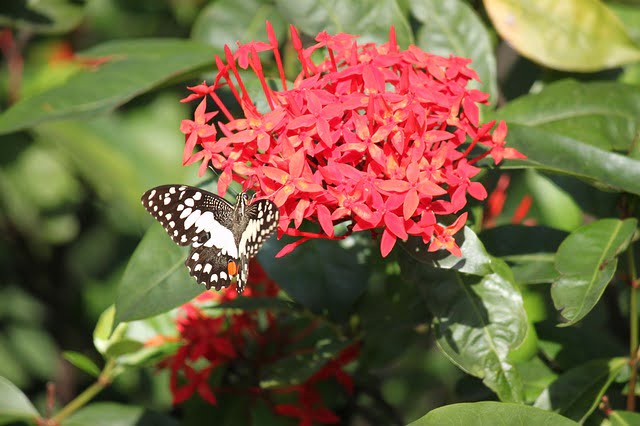This ultimate guide on Ixora plant care will help you to grow and care for your Ixora plant. Get to know ideal potting mix, sunlight, watering, etc. Also get to know pest & disease management of Ixora plant.
Table of Contents
Introduction
Ixora is considered to be flowering plants within the Rubiaceae family. It is the sole genus within the tribe Ixoreae. It is tropical evergreen trees and shrubs and have around 562 species.
Though native to the tropical and subtropical areas throughout the planet, its centre of diversity is in Tropical Asia. Ixora also grows commonly in subtropical climates within the United States, like Florida where it’s commonly referred to as West Indian Jasmine. Ixora is known by various names worldwide such as:
viruchi, rangan, kheme, ponna, Chann tinea, techi, pan, siantan, jarum-jarum/jejarum, jungle flame, jungle geranium, Cruz de Malta etc.
The plants possess leathery leaves, starting from 3 to six inches long, and produce large clusters of small flowers within the summer. Members of Ixora performs well in acidic soil, and are suitable choices for bonsai.
It is also a well-liked choice for hedges in parts of South East Asia. In tropical climates they flower continuously in a year and are commonly used in Hindu worship, as well as in Ayurveda and Indian folk medicine.
Ixora Plant Care Guide

Potting Mix
Ixora plant love moist, sandy loam to loamy soil that is slightly acidic. You can prepare the ideal potting mix with 60% loamy soil+ 20% cocopeat+ 10% sand. Or any well drain peat moss containing potting mix. You can use this potting mix for propagation of Ixora.
Selection Of Pot
For caring for Ixora, it is considered best to grow them directly in the soil. But you can also grow them in growing pots. I prefer to select 12 inches earthen pot for caring for Ixora plants. Make sure that the earthen pot have at least 2 to 4 drainage holes at the bottom.
Propagation
You can purchase seedlings from any nursery or propagate through cutting. If you want to propagate it from cutting than take 3 to 5 inches long shoot tips in spring.
Use rooting medium like IBA (Indole butyric acid) powder to induce roots in cutting. If you have no rooting medium no problem. Rooting medium increases success to develop roots in cuttings. Pick some leaves from below part of the cutting and clear one-inch bark where the rooting hormone will be applied.
Now wash shoot cuttings in low concentrate broad-spectrum fungicide. If you have do not have fungicide just wash it thoroughly in freshwater.
Now dip cuttings in rooting powder and transplant it into the potting medium by making a hole with pencil tips. Now press the potting mix to tight up cuttings in medium.
You can plot 5 to 8 cuttings in the container to develop seedlings. Do not cover it with transplant polythene. Just place your container under the semi-shade area. The cuttings will start rooting in 3 to 4 weeks.
Keep maintaining adequate amount of moisture till seedlings are developed properly. When seedlings are well developed, transfer each seedling into 6 to 12 inch diameter garden containers.

Sunlight
Ixora plant loves bright, direct sunlight for 5 to 8 hours daily. Place it where continuous light could be provided. Otherwise they can lose their leaves. But during hot summer days you will need to save your plant from direct sunlight.
During hot summer days, place your growing pot in the area where plant can receive filtered sunlight.
Watering
Ixora plant requires moderate watering. It loves moist but hates soggy soil. Overwatering can damage your plants. Apply water only when the top layer of soil becomes dry. Also take care of drainage to avoid root rot.
Fertilizers
Feed your plant with ½ teaspoon bone dust in a month for vegetative growth. Every year 2 to 3-inch topsoil should be replaced with fresh soil. To induce flowering Use NPK fertilizer (10:26:26) from spring to summer 5gm/lit solution every 15 days.
You can also use organic compost like vermicompost once after every 30 days. During flowering season, you can use banana peel fertilizer or onion peel fertilizer.
Pruning & Repotting
The size of the plant can be controlled by pruning. Remove and destroy all fallen leaves, prune all dead or infected branches. Use broad-spectrum fungicide as spray. Change pot as per the growth of plants.
Pests & Diseases
It is also prone to bugs and pests like mealybug, thrips, aphid etc. In such cases take 2 tablespoon Neem oil + 1 tablespoon mild soap dish and mix it well in one-litre water and spray that to the plant.
However you can also use the following methods.
READ MORE: HOW TO CONTROL MEALYBUGS
READ MORE: HOW TO CONTROL APHIDS
Importance Of Ixora
Ixora flowers are hardy flowers. They are of great economic importance; they’re ornamental plants and are grown for decorative purposes in gardens and landscape design, projects, as house plants.
Traditionally Ixora is found to be useful for many ailments like hepatic disorder, cancer, microbial infection, antioxidant, pain, inflammation, etc. and has been documented for various medicinal properties.
Ixora is also used to treat dysentery and tuberculosis.
Author’s Note
I thank Mr. Sital Sarkar for his contribution in this informative article on ixora plant care. If you have any ideas, suggestions, or queries then connect with me by commenting below. You can also connect with Agriculture Review on Facebook and Instagram.






